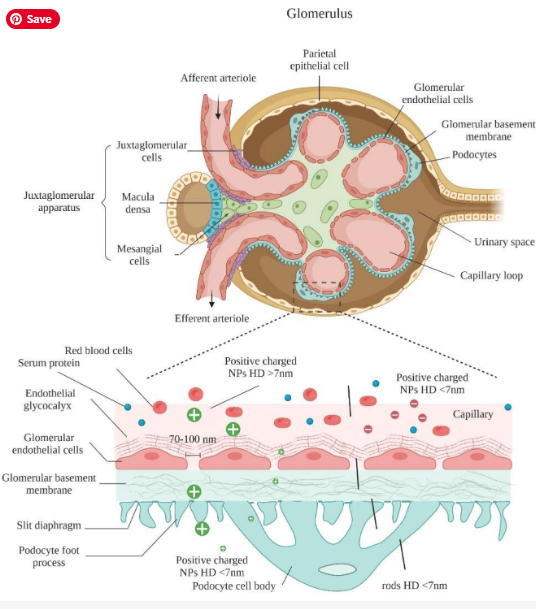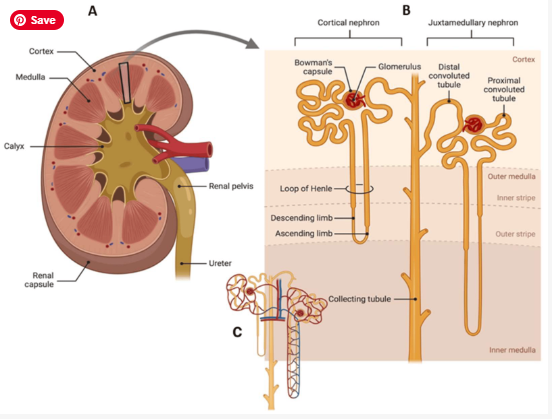Makindo Medical Notes"One small step for man, one large step for Makindo" |
|
|---|---|
| Download all this content in the Apps now Android App and Apple iPhone/Pad App | |
| MEDICAL DISCLAIMER: The contents are under continuing development and improvements and despite all efforts may contain errors of omission or fact. This is not to be used for the assessment, diagnosis, or management of patients. It should not be regarded as medical advice by healthcare workers or laypeople. It is for educational purposes only. Please adhere to your local protocols. Use the BNF for drug information. If you are unwell please seek urgent healthcare advice. If you do not accept this then please do not use the website. Makindo Ltd. |
Anatomy of the Glomerulus
-
| About | Anaesthetics and Critical Care | Anatomy | Biochemistry | Cardiology | Clinical Cases | CompSci | Crib | Dermatology | Differentials | Drugs | ENT | Electrocardiogram | Embryology | Emergency Medicine | Endocrinology | Ethics | Foundation Doctors | Gastroenterology | General Information | General Practice | Genetics | Geriatric Medicine | Guidelines | Haematology | Hepatology | Immunology | Infectious Diseases | Infographic | Investigations | Lists | Microbiology | Miscellaneous | Nephrology | Neuroanatomy | Neurology | Nutrition | OSCE | Obstetrics Gynaecology | Oncology | Ophthalmology | Oral Medicine and Dentistry | Paediatrics | Palliative | Pathology | Pharmacology | Physiology | Procedures | Psychiatry | Radiology | Respiratory | Resuscitation | Rheumatology | Statistics and Research | Stroke | Surgery | Toxicology | Trauma and Orthopaedics | Twitter | Urology
Related Subjects: |Heme |Globins |Myoglobin |Iodine |Cell Adhesion Molecules |B Lymphocytes |Anatomy of the Glomerulus
The glomerulus is a network of capillaries located at the beginning of a nephron in the kidney. It plays a crucial role in the filtration of blood, forming the initial stage of urine formation. The unique structure and function of the glomerulus allow it to effectively filter waste products, excess substances, and fluids from the blood while retaining essential proteins and cells.
Structure of the Glomerulus
- The glomerulus is composed of several key components:
- Capillary Network :
- A tuft of interconnected capillaries that receive blood from the afferent arteriole and drain into the efferent arteriole.
- Bowman's Capsule :
- A double-walled capsule that surrounds the glomerulus, collecting the filtrate produced by the glomerular capillaries.
- The space between the two layers is known as Bowman's space or the urinary space.
- Glomerular Filtration Barrier :
- Consists of three layers:
- Endothelial Cells : Lining the glomerular capillaries with fenestrations that allow the passage of water and small solutes.
- Basement Membrane : A thick, negatively charged layer that prevents the passage of large proteins and cells.
- Podocytes : Specialized epithelial cells with foot processes that create filtration slits, further restricting the passage of large molecules.
- Consists of three layers:
- Capillary Network :

Function of the Glomerulus

- Glomerular Filtration :
- The primary function of the glomerulus is to filter blood, removing waste products and excess substances while retaining necessary proteins and cells.
- Filtration is driven by the hydrostatic pressure in the glomerular capillaries, which forces water and solutes through the filtration barrier into Bowman's space.
- The filtration rate is influenced by various factors, including blood pressure, blood flow, and the properties of the glomerular filtration barrier.
- Selective Permeability :
- The glomerular filtration barrier is selectively permeable, allowing the passage of water, ions, glucose, and small molecules while restricting the passage of large proteins and cells.
- This selective permeability is crucial for maintaining the composition of the blood and the formation of urine.
Regulation of Glomerular Filtration Rate (GFR)
- GFR is the rate at which blood is filtered through the glomeruli, and it is tightly regulated to ensure homeostasis:
- Renal Autoregulation :
- Maintains a constant GFR despite fluctuations in blood pressure.
- Mechanisms include the myogenic response (constriction or dilation of afferent arterioles) and tubuloglomerular feedback (adjustments based on the flow of filtrate past the macula densa).
- Hormonal Regulation :
- Renin-Angiotensin-Aldosterone System (RAAS) :
- Activated in response to low blood pressure or low sodium levels.
- Renin released by the juxtaglomerular cells converts angiotensinogen to angiotensin I, which is then converted to angiotensin II, a potent vasoconstrictor that increases blood pressure and stimulates aldosterone release.
- Atrial Natriuretic Peptide (ANP) :
- Released by the atria of the heart in response to increased blood volume and pressure.
- Promotes natriuresis (excretion of sodium) and diuresis (excretion of water), reducing blood volume and pressure.
- Renin-Angiotensin-Aldosterone System (RAAS) :
- Neural Regulation :
- Sympathetic nervous system activation can constrict the afferent arterioles, reducing GFR during stress or emergency situations.
- Renal Autoregulation :
Clinical Relevance
- Glomerular Diseases :
- Diseases affecting the glomeruli can lead to impaired filtration and kidney function.
- Glomerulonephritis : Inflammation of the glomeruli, which can be caused by infections, autoimmune diseases, or other conditions.
- Diabetic Nephropathy : Damage to the glomeruli due to chronic high blood sugar levels, leading to proteinuria and chronic kidney disease.
- Hypertensive Nephropathy : Damage caused by chronic high blood pressure, leading to glomerulosclerosis and reduced kidney function.
- Diseases affecting the glomeruli can lead to impaired filtration and kidney function.
- Measurement of GFR :
- GFR is an important indicator of kidney function and is measured using various methods, including serum creatinine levels and creatinine clearance tests.
- Normal GFR ranges from 90 to 120 mL/min/1.73 m², with lower values indicating impaired kidney function.
- Proteinuria :
- The presence of excess protein in the urine, often an early sign of glomerular damage.
- Can be detected using urine dipstick tests or more precise laboratory measurements.
Summary
The glomerulus is a vital component of the kidney's filtration system, responsible for the initial stage of urine formation. Its unique structure and function allow it to selectively filter blood, maintaining homeostasis and ensuring the removal of waste products. Understanding the physiology of the glomerulus and its regulation is crucial for diagnosing and managing various kidney diseases and conditions.